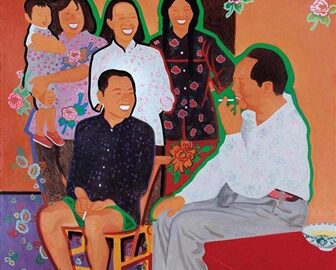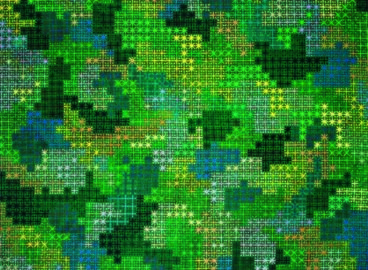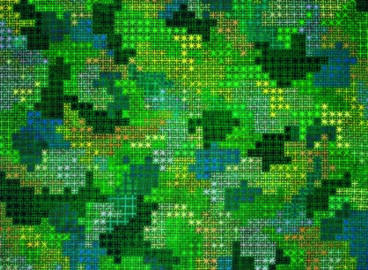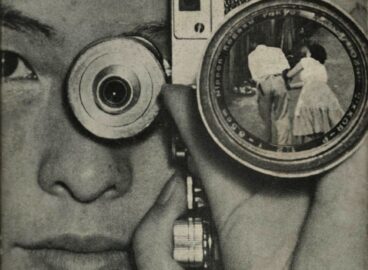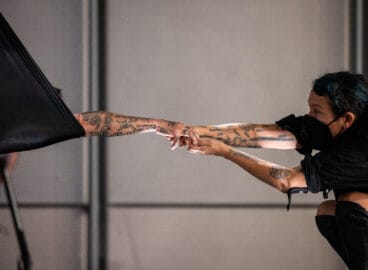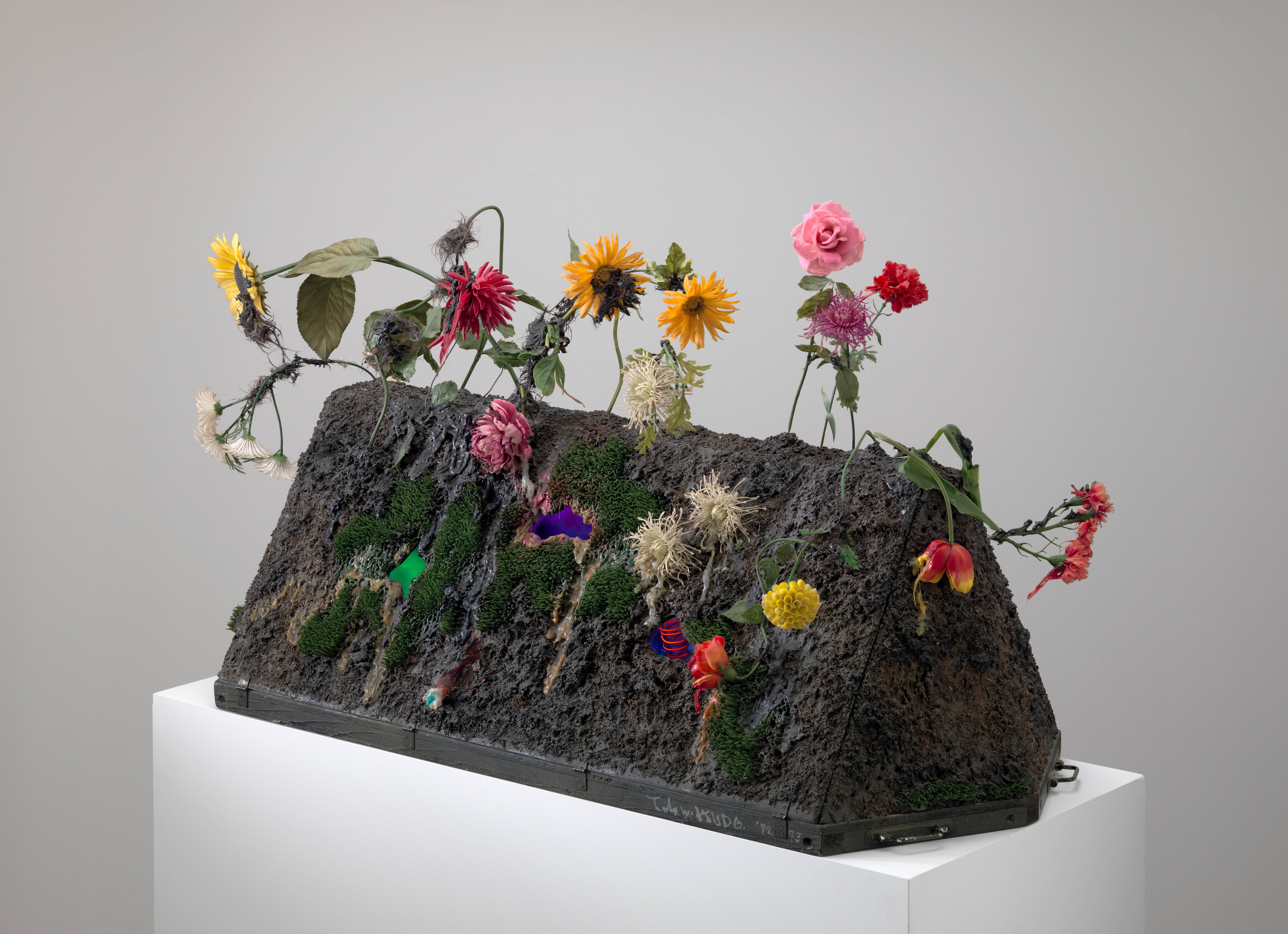For the artist Yang Jiechang (b. 1956, Foshan), there is a certain similarity between
contemporary artists and China’s Red Guards of the 1970s: namely, their performance of arbitrary tasks. In this conversation, Yang talks about his “art education” during the Cultural Revolution, when he served as a Red Guard in a small village, and describes how the study of calligraphy extinguished his enthusiasm for revolution and political propaganda.
Although Yang has been living in Europe since 1988, the Chinese brush remains an essential tool in his experimental painting practice. He discusses Hundred Layers of
Ink, a series of abstract paintings he developed for the exhibition Magiciens de la terre (1989, Centre Georges Pompidou, Paris), combining Chinese ink, Zen philosophy, and the surrounding space. He views calligraphy and abstraction as neither the same thing nor as contradictory. For Yang, the central value of calligraphy lies not in the aesthetics of the written signs but in the methods used to achieve them —methods that can be applied to other art forms and mediums, and even to life. Yang takes a dim view of the fashion for group shows of contemporary Chinese art, calling it “the Chinatown phenomenon,” and an even dimmer view of art censorship in China. These trends have strengthened his conviction that more research remains to be done on contemporary Chinese art.
The conversation published below was held in Chinese in Yang Jiechang’s Paris
studio on June 24, 2014. The Chinese version of the interview can be accessed at the bottom of this page; the transcript has been translated by Yu-Chieh Li.
Read the interview in Chinese here.
Part 1: The Artist’s Testament
Yu-Chieh Li: We were talking about your work Testament [1992], which is right
behind you. What inspired you to make this work?
Yang Jiechang: First I must explain what led up to it. I left China in December 1988,
came to Paris in April 1989, and started to create work in situ for the exhibition
Magiciens de la terre at the Centre Pompidou. On June 3 that year, there was a gun
shot on Chang’an Street in Beijing [the Tiananmen incident]. As a university professor, I was confused and couldn’t believe what had happened was real. You know what happened, right? As a person educated in China in the 1980s, when the spirit of the times was so romantic and optimistic—all about humanity, enthusiasm, knowledge, and saving the nation—I found the situation extremely hopeless. I didn’t know whether I was dead or alive after learning about this disaster. I suddenly lost my goal in life.
On December 9, 1988 I had traveled to Heidelberg at the invitation of Martina [curator Martina Köppel, now Yang’s wife]. The real reason for my trip was the show Magiciens de la terre. Participation in cultural events of this kind was usually treated as an official cultural exchange and was supported by the Chinese government.1Jean-Hubert Martin, the curator of the exhibition, did not go through Chinese government channels when he invited Yang to participate. This created difficulties when Yang applied for a passport to travel abroad. The government wouldn’t consider me for an official cultural mission, which would have had to be reviewed by my school and reported to the office of education of the province as well as the central government.
The work Testament was made for the exhibition Emergency Exit [1992] in Fukuoka,
Japan, curated by Fei Dawei. I had a hard time thinking about how to unburden
myself of the past. I felt like an intellectual drifting abroad. In Japan I was inspired by the [seventh-century] Tamamushi Shrine, which is decorated with a painting depicting the story of Prince Siddhartha feeding himself to a tiger, one among multiple stories of the Buddha. The story is well known in Japan, so I thought, why not cite this wellknown story so that my work could be well received by the Japanese? I made use of two Japanese traditions, namely Zen Buddhism and ceramics. I simply applied white glaze to a found ceramic jar and fired it. Since it is used for storing tiger shit, didn’t have to be finely made.
I wanted to present the idea of an intellectual turning into tiger shit one day and filling up this ceramic jar. It makes me think that my pride in myself as an intellectual is now deconstructed. When this pride is turned into tiger shit, I am liberated. From there I adopted a new life philosophy. I didn’t care about politics that much anymore, and I wanted to free myself. Art is more interesting. Art has often saved me.
Testament includes a wall text, which states, “One day I will die an unnatural death.
When I die, my corpse should be fed to a tiger, and its excrement should be
preserved.” Zen is the present. It is action, life, religion.
Part 2: Action Painting vs Painting with Action
Li: Martina took us to see Massacre and Setting Fire, two oil paintings you did for
your graduation show [1982]. They are very expressionistic.
Yang: Very straightforward.
Li: What were you experimenting with?
Yang: I belong to the first generation of students that attended China’s art academies when they reopened after the Cultural Revolution. During the revolution, art was produced solely as political propaganda. It had to portray human beings as healthy and positive—tall, big, glowing, and complete. By the time the art academies
reopened and started admitting students in the late 1970s, applicants constantly
practiced drawing heads of Liberation Army soldiers, knowing that portraiture was a
standard subject on the entrance examination. After we were admitted, we had to
continue drawing heads; the whole curriculum was about that. Those heads have no
personality—they are portraits of workers, farmers, and soldiers, all smiling, viewed
frontally or in one-quarter or three-quarter profile. By the end of my studies at
Guangzhou Academy of Fine Arts, I was sick of it: I realized that I was very good at
drawing heads, but that I’d never painted the heads of dead people. I thought of that
project as both a continuation of our tradition and a challenge. I was very excited—
that was the background of Massacre. But I had too many professors on my
graduation committee, and each one had a lot of opinions. My ink painting with heads of dead people was criticized, so I painted another work, Setting Fire, the six-panel painting you saw. Now I think it’s good that they were both rejected—at least they belong to me. Whenever I see them I feel that I am young again. And in the end, after graduation, I managed to get a job as a lecturer at my school.


Li: If you wanted to reform the old-fashioned way of drawing heads, why did you
adopt violence and negative ways to work on the two paintings—killing is a negative
theme after all.
Yang: After serving as a Red Guard and reading works by Nietzsche and
Wittgenstein, our generation was always looking to the opposite side of things. I
believe there can be tears behind smiles. Behind health there is death. I was simply
looking for something negative to express my feelings. Of course today I am more
capable of thinking of other possibilities [for reforming painting]. But at that time I
thought I could effect change by transforming the head. I thought killing is eternal and it happens every day. Other students worked with subject matter that was positive and beautiful.
Li: This is a photograph of you in your studio jn 1986 with some paintings done in 1985. It seems that you did splash ink and abstraction.
Yang: Not abstraction. I was deconstructing the figurative. My deconstructions are simple: they remain representational, and every form has concrete origins. I like Xu Wei’s painting,2Xu Wei (1521–1593) was a Ming dynasty painter known for his expressionistic style. and I imitated some of the details I found in his work. For example, I magnified a detail of an image he did of rotting lotus leaves in a big painting that I made using three brooms tied together as my brush. There wasn’t a brush big enough for a painting of that scale—not to mention the fact that I don’t have money to buy brushes. The brooms had to be boiled and softened in water. The effect they produced is very different from that of the traditional brush. Unlike traditional literati, I have a very dirty workplace. I place my xuan paper on an old curtain or a piece of linen soiled with ink and dust, and that creates special textures on the painting field.
In the 1980s I didn’t know anything about Mark Tobey or Japanese Zen paintings. Artists in China didn’t have that kind of knowledge. When I studied art history at school, modern art was missing from the curriculum. I was surprised when people in Paris and New York said I was imitating Mark Tobey and Robert Motherwell. I didn’t know about them. A journalist in Oxford asked me if I was imitating Kasimir Malevich. I didn’t even know who Malevich was; I thought he was a fictional character—the driver in the film Lenin in October. Tobey and Pollock got their inspiration from East Asian art, adding some romanticism to it. When there is an artist from East Asia doing something similar, it is interpreted as imitation. This is wrong. Why not say those artists imitated me? There are Chinese artists of many different generations, but our roots are ours, deep in the blood. Starting from the time I began learning calligraphy at the age of three, I was learning this kind of action painting. Chinese calligraphy is a discipline immersed in this kind of action. You can judge artists by looking at their calligraphy or their comments about art. It is very conceptual. Jackson Pollock plays with body, size, black and white, with dot, line, surface, and material. By contrast, Chinese brush painting is not only about the medium. It is also about ideology, and a lot about self-cultivation, so that your taste in art and aesthetics improves as you get older. It depends on your participation in society as well as on your circle of friends. Chinese art is multi-faceted.
Li: Were you painting on the floor at the time [of your graduation]?
Yang: Yes. I never painted at a desk. My teacher taught us not to rest our wrists on the paper [writing surface] while practicing calligraphy. You have to raise your wrist, sit upright, and channel your energy into the brush so that you keep a distance from the writing surface. You keep a distance and at the same time you still have good technique and control precisely where the brush goes. If, on the contrary, you write
calligraphy while resting your wrist on the paper, you are too close to the writing surface and won’t be able to pay attention to the larger view of the writing area; you will be too immersed in the details. You are able to maintain only a short distance from the writing surface if you sit at the desk to write; if you place the paper on the floor, you get a longer distance. You will be able to observe the entire picture surface and see the whole composition. You control the painting in your mind without limiting yourself to the details—although each stroke is based on the detail. Your power is good. The Chinese have been doing that for 3,000 years.
Li: When did you sell your first painting?
Yang: Good question. A Siemens engineer who was producing hearing aids came to China to do market research. He visited my studio with a translator in the summer of 1986 or 1987. He was particularly interested in my preliminary sketches for Killing —not the final painting, just the sketches. I have a vivid memory of that because someone was buying my work! His translator told me in Cantonese and Mandarin that I should raise the price. I didn’t know how to, so I asked for 100 RMB. He paid in FECs [foreign exchange certificates]. The painting was about 60 centimeters by 100 centimeters, and I gave him another work as a gift. The translator thought I was stupid. I was merely being thankful, because the price was higher than my monthly salary. I simply felt so grateful that someone appreciated my art. I think research into the ’85 New Wave phenomenon should start with personal stories instead of concentrating on group activities initiated by the idea of revolution. Artists found the energy to struggle with their art at a time when they were not even able to feed themselves. When they were able to make art, they had nowhere to show it, and so they piled it up in the corners of their places. No one wanted their works, even as gifts. Artists were very romantic, and they aspired to go beyond the self. I can name a few who initiated the personal practices of the ’85 New Wave: they include Cai Guoqiang, Chen Zhen, Chen Tong, myself, and Ding Yi. We weren’t a collective and were not interested in organizing collectives. We all went through very painful personal struggles.
Li: According to some sources, you took up abstraction in the early 1980s. Is this
true? Were you doing abstract calligraphy?
Yang: I think calligraphy is mysterious, smart, and concrete—just like Chinese characters. There is energy in each character, and this point is rarely discussed. Foreigners think calligraphy is abstract because they don’t understand the meaning of the scripts. For us, the character for “wood” is represented by a tree 木, the character for “person” is a man walking 人—they are pictograms. When I write a person’s name, this person seems to live under the brush—it’s very concrete. I never think of calligraphy as abstract. Even if I write cursive scripts in the style of Zhang Xu or Huaisu,3Zhang Xu (659–747) and Huaisu (737–799) were renowned Tang dynasty calligraphers. they are still concrete and legible.
In calligraphy there are lots of rules—we call them methods [fa]. The methods can be compared to world views. I think the brush is very interesting in that it is inexpensive, however, it can add value to your life as long as you master calligraphy over time. By practicing calligraphy, you can control your life in its different stages and improve your judgment. You even learn about aesthetics through writing the strokes. Everyone is an artist as long as he or she holds a brush. I think Joseph Beuys’s statement can be revised as, “Everyone who thinks of himself as an artist is an artist.” If you hold the brush, you feel as if you are a cultivated person. In the past, not everyone was privileged enough to hold a brush. Only one or two smart children in a village had the opportunity to be educated. The whole family would work hard to support the education of this child. This child held the brush and held the future of the clan. The brush embodies a kind of elite. The brush means a lot of responsibility, and not everybody can take it.
Part 3: Contemporary Art and the Cultural Revolution
Li: How did the Cultural Revolution influence your art?
Yang: It was a great and wonderful influence. I don’t criticize the Cultural Revolution
because I experienced it when I was young, so I always try not to be too subjective in my comments. During the Cultural Revolution we were unable to go to school for years, so we acquired our knowledge from “social practices.”4Schools in many regions were closed during the Cultural Revolution (1966–1976). When I was a member of the Red Guard, my job was to supervise school buildings and to censor bookscollected from schoolchildren—some of the books had to be destroyed or sold. In 1970 I served in a rural area where my job was to guard a telephone cable located in the fields.5During the Cultural Revolution, many urban youths responded to Mao’s call for them to move to the countryside and work with farmers and rural workers. I even had to stand watch at midnight to be sure the line wouldn’t be harmed. In retrospect, performing this duty helped me understand the nature of contemporary art: it’s very arbitrary, and there is nothing to argue about—you just have to watch the cable and make sure nobody comes to cut it. All the students in our class became members of the Red Guard, and each was responsible for a section of this cable. It was very absurd! The action was even more conceptual than the art of Joseph Beuys or Nam June Paik.
Li: Did you continue practicing calligraphy during the Cultural Revolution because you had to write big-character posters?
Yang: In fact, I never wrote big-character posters. I was lucky to have a good
calligraphy teacher. In the beginning I studied calligraphy because I wanted to write
big-character posters. My teacher knew that, so he held me off. Traditional methods
for educating literati are very weird. At first he wanted me to be some sort of
apprentice, wiping the table and windows, grinding ink and cutting papers. My father used connections to get me into his studio, and the teacher wanted to test my aptitude for such studies. I was very interested, so he started to teach me calligraphy styles on bei and tie.6The Chinese used to carve great works of calligraphy on stone slabs (bei). The rubbings (tie) were circulated as models for students. I began copying the stone inscriptions of the Diamond Sutra on Mount Tai. A few months later I found out that this particular calligraphic style is not suitable for big-character posters, so I intended to switch to the style of Ou Yanxun’s inscription at the Palace of the Nine Perfections, which was similar to the Song font used in book printing.7Ou Yangxun (557–641), a Confucian scholar and calligrapher, developed a script admired for its dignified harmony and structure. My teacher said calligraphy is not a practical discipline—you just study the methods. Through his teaching method he suppressed my desire to participate in the Cultural Revolution and write big-character posters.
Li: You studied Daoism from 1984 to 1986.
Yang: In the 1980s, translations of many Western books of philosophy, theory, and
fiction were published in China. I read a lot about the East and West, mechanics,
religions, sex, philosophy, wars, novels, etc., but I felt that the more I read, the more
confused I became. My mind was very unsettled, so I wanted to learn a method to
calm myself through religion. A friend, Zangzhi, introduced me to a famous Zen
temple—the Guangxiao Temple in Guangzhou. At that time there were almost no
pupils in the temple, and no educated person would go there. I was annoyed by the
hierarchy there, because Buddha talks about equality, right? I fled after two weeks. At that time my knowledge of Buddhism came from books by writers such as Suzuki
Daisetzu, who presents a philosophy that differs totally from Buddhism as it was
practiced at the temple. Not long after, I went to the Chongxu Temple on Mount Loufu and studied with Master Huang Tao. It was a place with very beautiful scenery and fresh air. Nearby was Lin Biao’s villa. Master Huang was bored and maybe lonely. He lived with one assistant in the big temple, so he accepted me. I felt that I was taking advantage of them by boarding there, so I started to restore some of the temple’s Qing dynasty murals. I stayed there on and off for two years mainly to talk to the master and restore the murals. At that time I didn’t have to teach much as a lecturer at the university [Guangzhou Academy of Fine Art]. The experience I had on the mountain was actually a disaster because the master didn’t teach me anything! I
thought Huang Tao knew a lot because he was the chairman of the Daoist association of Guangdong Province and vice-president of the Daoist association of China. Strangely, as my knowledge of Daoism increased, I considered him more and more important. I think his teaching methods come from abstruse Daoism.
Part 4: Hundred Layers of Ink
Li: How did you start to work on the Hundred Layers of Ink series?
Yang: I started to do experimental ink painting when I was still in China. At first I tried to deconstruct traditional painting. Around 1986 I took my inspiration from oracle bone scripts and rubbings of stone inscriptions, and gradually I turned to a minimal style. I still have about 10 of the minimalist paintings. Jean-Hubert Martin selected works from that series for Magiciens de la terre, but they were seized by customs in Shenzhen. When I arrived in France I had only a brush with me. My problem was that I really didn’t know what to paint after coming to Europe. Martina told me how famous the other artists in Magiciens de la terre were. My work would be shown next to Nam June Paik’s, and then there was Anselm Kiefer, Ilya Kabakov, On Kawara, Alighiero Boetti, Sigmar Polke, Sarkis, and Jeff Wall was not far away. I thought that if I showed abstract ink works, it would look as if I was following a path initiated by other, better known artists. My culture has taught me that sometimes it is better to step back than to progress. In Paris I was using brush, ink, and xuan paper not to paint but to express a notion of action. Every day I repeated the process of applying layer upon layer of ink to xuan paper after the previous layer had dried. When xuan paper is soaked with ink, it deforms slightly. I applied about 100 layers of ink so that the paper was no longer flat and smooth, but wrinkled. The end result was not painting but a record of my work over time.
Since I had created space and distance between the layers of ink in those paintings, I hung them in the exhibition at a distance from the wall so that spectators would feel as if they were entering another space.

Li: Is this a kind of addition?
Yang: Well, if you repeat this boring gesture every day, it becomes a means of
reduction. I studied a technique fundamental to Song and Yuan dynasty painting in
which colors and glue alum solution are applied repeatedly to achieve the saturation
of color: three layers of glue alum solution and nine layers of color. For example, the
red would be a bit transparent but it has many layers and differs greatly from when
you apply it only once. Hundred Layers of Ink employs a similar technique. Black
became not just black; there is light in it.
In 1999, a huge storm swept over Europe. Many trees in Germany and France,
including those at Versailles, were uprooted. At that time I started to prepare for Paris pour escale (2000) at the Musée d’Art Moderne de la Ville de Paris, so I started to work in the refined gongbi style that in the past was used in figurative and bird-and-flower painting and which I studied through the Huizong emperor’s painting style. It seemed to elicit a more direct audience response. I mean, my Hundred Layers of Ink is a kind of abstract art that requires intelligent interpretations, but non-abstract painting can be more powerful in engaging the audience.
Part 5: The Chinatown Phenomenon

Li: You have said that artists of your generation hopped on the bandwagon of postcolonial theory. In the early 1990s there were many group shows overseas, including exhibitions in Berlin and Oxford in 1993, that labeled you and all the other participants as Chinese artists. Many people were initially interested in Chinese artists because of their passion for foreign cultures. Can you comment on this, and do you think the exhibitions in 1993 affected your practice?
Yang: The unfortunate thing is, these exhibitions were mostly done by people who
loved China, who had been to China, or even Europeans who believed in Maoism. I
preferred two exhibitions curated by Fei Dawei. One of them was the show he did in
southern France, Chine demain pour hier [1990,Pourrières].
Fei had some experimental ideas. He thought contemporary Chinese art had not yet
come fully into existence and that presenting a group of artists as representative of
contemporary Chinese art—taking the Chinatown approach—was misleading. Since
contemporary art in China was just emerging, one shouldn’t try to present the whole view. He was more interested in showing art of the elite because contemporary art is a form of elite culture.
The show in Berlin in 1993 was problematic—I think it had a negative influence
because it was curated by people who know nothing about art. Hans van Dijk, Jochen Noth, and Andreas Schmid were businessmen: Hans sold old Chinese furniture; Andreas, the German guy, had just graduated from the China Academy of Fine Arts. Chinese cuisine is diverse, but they didn’t cook it well and turned it into fried rice sold at Chinese restaurants overseas. They served it in Berlin at the Haus der Kulturen der Welt.8In the exhibition China Avantgarde. Their approach was not at all like Jean-Hubert Martin’s in Magiciens de la terre (1989). Martin spent three years working on that exhibition, and he put Chinese art and art from around the world on the same platform. Fifty well-known masters and 50 artists from third-world countries were represented on the same platform so that we could be in dialogue on the same level. David Elliott, the director of the Museum of Modern Art in Oxford, totally understood that concept. He didn’t take over the entire content of the Berlin show but instead re-curated it, adding nine works when he presented it in Oxford as Silent Energy: New Art from China, which was of high quality. After that, contemporary Chinese art became a battleground of capitalism and theories of sociology, involving people and institutions like Li Xianting, who coined the term “cynical realism;” Shoeni Gallery in Hong Kong, Johnson Tsong-zung Chang from Hanart TZ Gallery, Guy and Myriam Ullens from Belgium, Uli Sigg from Switzerland, Xu Jiang, Professor Wu Hung.
Li: Were you ever censored?
Yang: Everybody is monitored today!
- 1Jean-Hubert Martin, the curator of the exhibition, did not go through Chinese government channels when he invited Yang to participate. This created difficulties when Yang applied for a passport to travel abroad.
- 2Xu Wei (1521–1593) was a Ming dynasty painter known for his expressionistic style.
- 3Zhang Xu (659–747) and Huaisu (737–799) were renowned Tang dynasty calligraphers.
- 4Schools in many regions were closed during the Cultural Revolution (1966–1976).
- 5During the Cultural Revolution, many urban youths responded to Mao’s call for them to move to the countryside and work with farmers and rural workers.
- 6The Chinese used to carve great works of calligraphy on stone slabs (bei). The rubbings (tie) were circulated as models for students.
- 7Ou Yangxun (557–641), a Confucian scholar and calligrapher, developed a script admired for its dignified harmony and structure.
- 8In the exhibition China Avantgarde.




